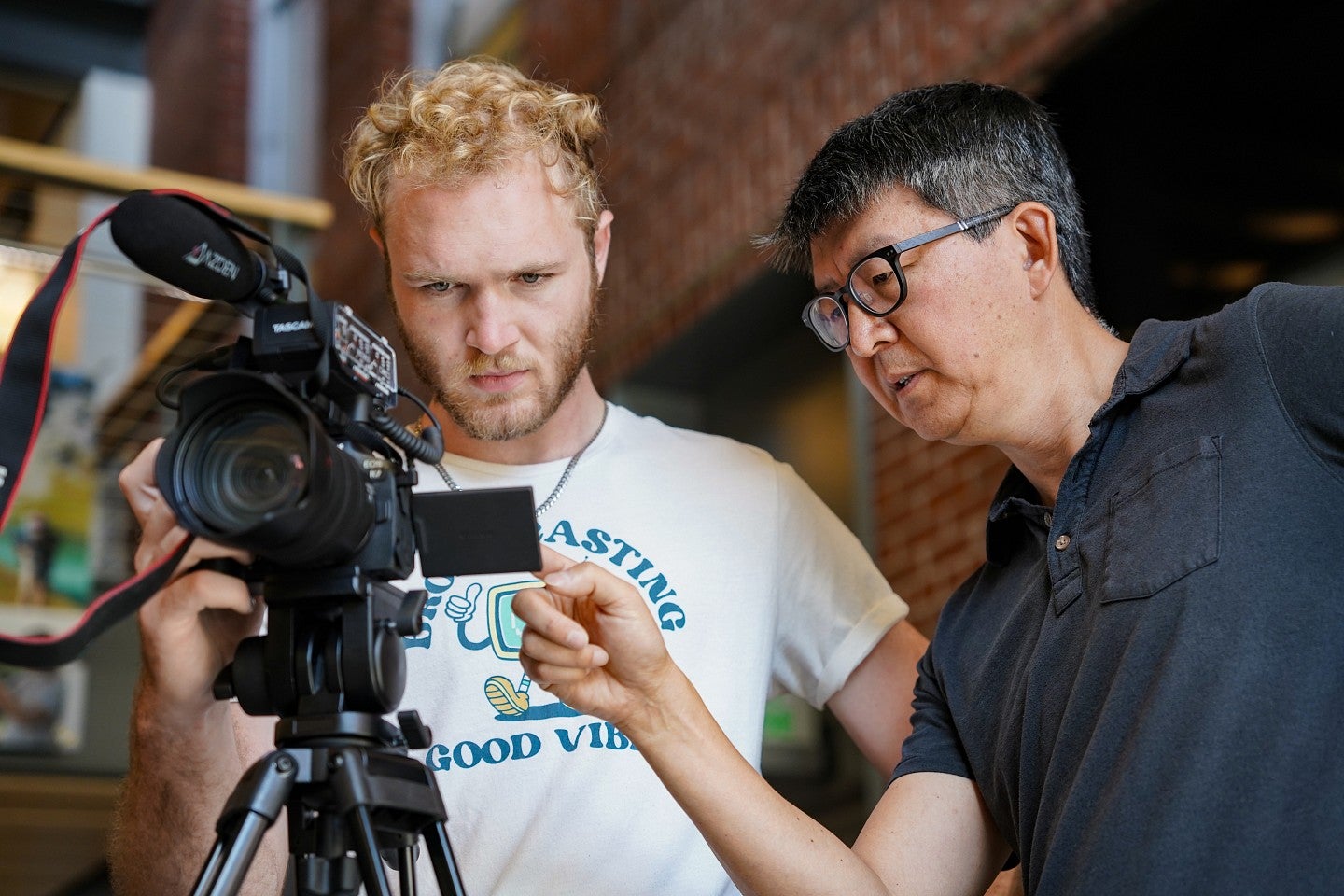
Since 1916, Oregon journalism students have studied the importance of reporting, editing, investigating and storytelling with faculty who keep their students at the front lines of technology and trends. Today, the UO School of Journalism and Communication’s (SOJC) journalism program, which includes an undergraduate major and master’s programs in journalism and multimedia journalism, is evolving at its fastest pace ever to prepare students for a field that’s going through big changes.
“As my generation graduates and starts their careers in the journalism industry, I see the chance for fresh perspective, ideas and creative expression,” said Chrissy Booker ’23, currently a health and nonprofit reporter for The Columbian, a newspaper in Vancouver, Washington. “We’re no longer only telling the stories of the CEOs or millionaires, but the working class, the BIPOC and queer communities, who have historically been undermined. As a Black woman and young journalist in the industry, I want to be side by side with people who aren’t afraid to subvert expectations.”
While the journalism industry has evolved, Damian Radcliffe, journalism professor of practice and Carolyn S. Chambers Professor in Journalism, said that students’ interest in journalism has remained strong. He believes that it is due to their passion for storytelling and their desire to make meaningful change in their communities.
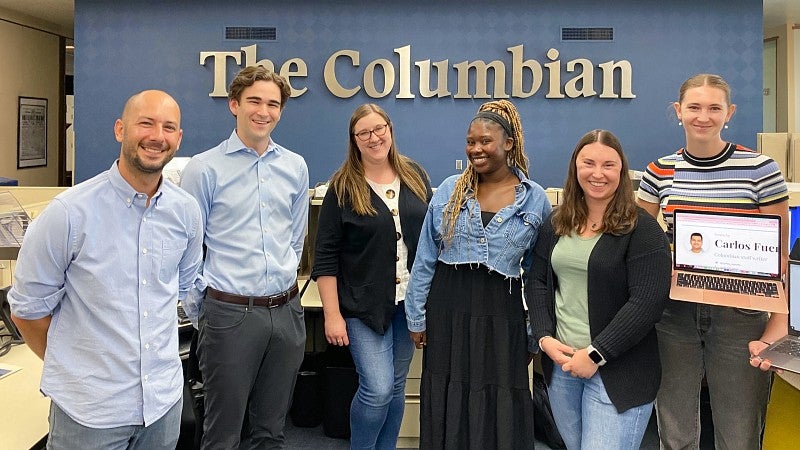
“So many of our students are really driven by issues, like social injustice, climate change, LGBTQ rights and so forth,” Radcliffe said. “And they recognize that to advocate for, advance and inform people about those issues, journalism can be an incredibly potent tool to do that.”
This has been the case for Alexis Weisend ’23, who is also a reporter at The Columbian. When she was recently covering a story, a local mayor remarked that he was surprised young people pursued journalism.
“I was like, ‘You’d be surprised. America’s local newsrooms are run by kids who just got out of college basically,’” Weisend said. “We told him we love the work. Nobody does this for money. We do it because we love it, and we see a lot of value in it. I think that our generation saw a lot of political turmoil, a lot of things that were unfair. We also saw people become distrustful of the news, and I think that growing up with all that, it kind of switched the mindset to that community-focused journalism. I think that younger people like us really see it as a public service.”
A journalism program that goes beyond the classroom
The SOJC structures its undergraduate and graduate journalism programs around teaching foundational principles in journalism, including strong writing skills and media ethics, and giving students opportunities to gain hands-on experience through internships as well as student-run organizations and publications. Weisend believes the hands-on experiences the SOJC offers sets it apart by giving students the chance to learn — and fail.
“It’s really important because you need to make a lot of mistakes before you walk into the newsroom and work full time,” Weisend said. “Because remembering those mistakes and learning from those mistakes, that’ll stick with you forever. I’ve made so many mistakes, but I don’t feel stressed out anymore the way I used to be stressed because I knew how to do this before walking into my newsroom.”
Alum Grace Murray ’22, who works as a freelance journalist, also found that her classes and extracurriculars that took the hands-on-learning approach made her more self-sufficient, as she was able to grow from her mistakes before entering her career.
“You don’t need as much help,” Murray said. “All of the things that I did at the Daily Emerald, FLUX and as an ambassador [for the SOJC], I am doing now. When I get asked [in a job interview], 'Can you show me an example?’ I have examples of things that I have done, that are things that can help me in my professional career.”
Murray has known she wanted to be a journalist since she was young, as it allowed her to explore different niches, especially in arts and culture. This idea was also appealing to alum Kayla Nguyen ’23, an editorial assistant at Harvest House Publishers who describes journalism as a learning profession.
“You are constantly learning about something new every day and absorbing the information that you uncover when piecing together a story,” Nguyen said. “That aspect of not knowing what I will cover every day is something that really excites me. Journalism is like no other profession.”
It’s because of this diverse range of topics that Murray enjoys doing freelance work, and she thinks journalism equips people for many different careers.
“Once you learn how to be a journalist, you’re learning how to talk to people all the time, how to build teams, and be creative, develop writing skills, photography skills,” Murray said. “There’s so much that you learn from a journalism major that you can go off and do just about anything. You can find a job that suits you. You have the skills that you can thrive in whatever you’re interested in.”

Journalism program shifts focus of reporting
Professor and Shirley Papé Chair of Emerging Media Seth Lewis, who is also the director of the journalism program, says the SOJC is a national leader in relational journalism, which is when journalists and news organizations focus on relationship-building with their audiences.
“It’s a way of thinking — a mindset as well as a strategic approach — that encourages journalists to build mutually beneficial relationships with the people they serve, in a dialogical kind of way that promotes trust and understanding,” Lewis said. “We need to make sense of what the value proposition of news really is in people’s lives, and a relational journalism approach can help us move in that direction.”
For Endowed Chair in Journalism Innovation and Civic Engagement Andrew DeVigal, journalism’s main role is to bring communities together. He agrees that the idea of journalists as gatekeepers is no longer relevant.
“Solutions, engagement and collaboration,” said DeVigal, who directs the SOJC’s Agora Journalism Center, a journalism-industry-serving forum for the future of local news and civic health. “To me, these are the magic trio of the future of journalism, when we want to authentically engage with each other, especially the public and community members, so that our reporting is much more community-centered.”
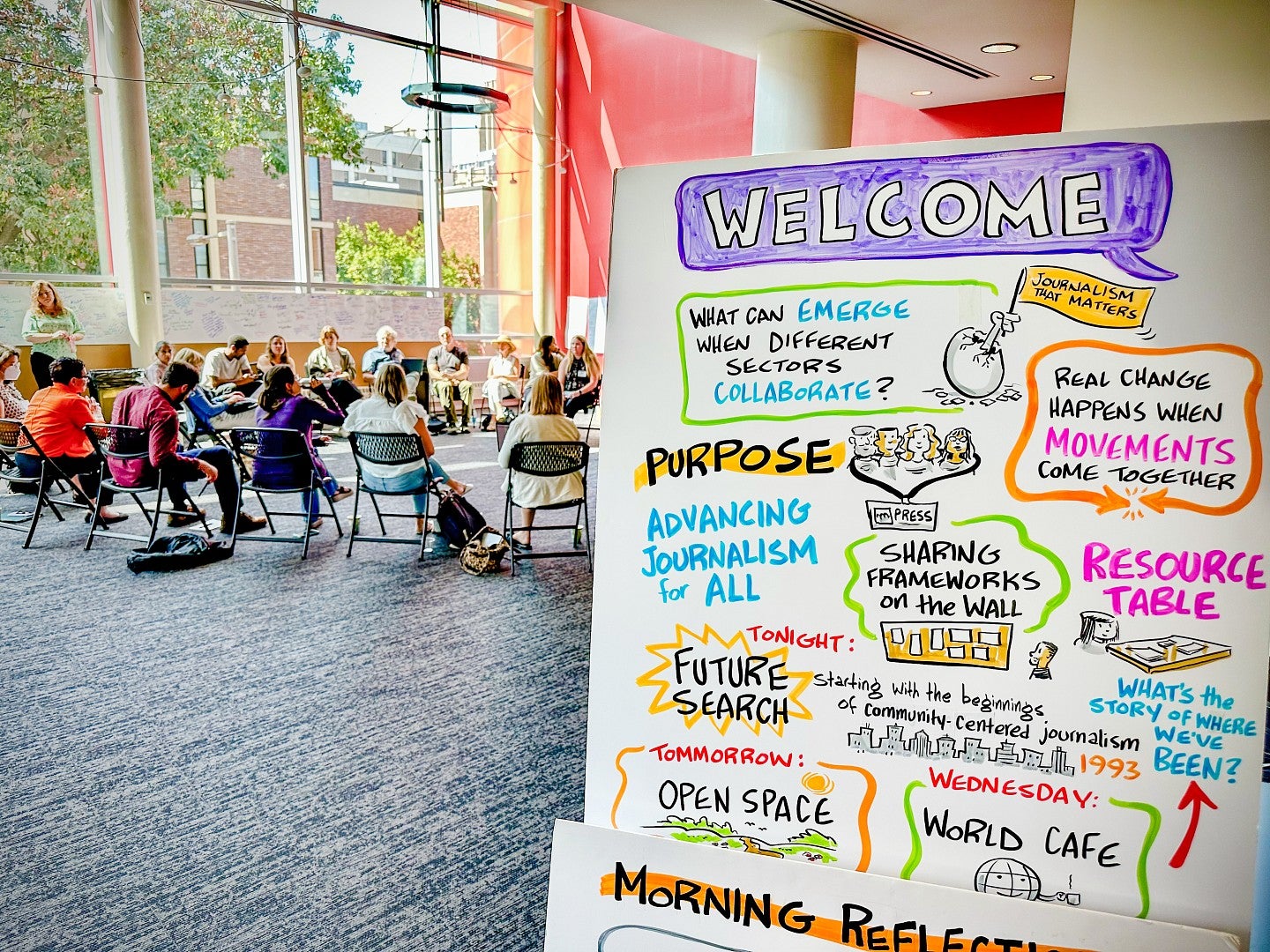
The Agora Journalism Center, founded in 2014, operates on the principle that journalists should forge collaborative relationships with their to create meaningful impact. This focus on community journalism — sometimes called engaged journalism — also encompasses solutions journalism, an approach that highlights the people and organizations successfully addressing societal problems such as climate change, income inequality and houselessness.
“It’s really simplifying the complex for the world,” DeVigal said. “To find solutions about what’s ailing us as a community so that we have the appropriate evidence-based information and facts, and stories, to really elevate how we operate as a community and as a society. I feel like the more we are able to collaborate with community members to help solve issues that we’re facing as a community, then we are doing our jobs as journalists.”
Lewis sees community journalism as a way to make journalism more responsive and reflective of the community it is trying to serve.
“I think more and more journalists are understanding the need to engage with the audience, not just in terms of having them come to the website or subscribe, but really listen to them, learn from them and make journalism a more dialogical back and forth, an exchange of mutual benefit,” Lewis said.
Similarly, Radcliffe defines community journalism as journalists working with their audiences to help determine what stories need to be told, breaking away from the historical model of journalists as gatekeepers of news.
“Communities often have very specific information needs that we might be blind to,” said Radcliffe, who researched and wrote an Agora-funded report called “Redefining News: A Manifesto for Community-Centered Journalism.” “And therefore, working with them to identify those needs and to meet them is part of what we, as journalists, should be doing.”
For Radcliffe, this also means acknowledging the harm that has been done by journalism historically to certain communities.
“We’re recognizing that journalism hasn't always been good for certain communities and that certain communities have been overlooked, have been disenfranchised, have been poorly treated by the media industry,” Radcliffe said. “And I think our students are really aware of that and really kind of hungry to address all of those long-term structural challenges. And that really drives a lot of the work that they are doing and that they want to do.”
The SOJC funds two hands-on-learning journalism programs, with the support of donors, that advance community and solutions journalism. The Charles Snowden Program for Excellence in Journalism places journalism students from around the state as interns in community news outlets throughout Oregon. The interns embed themselves in the local communities and report on local news, covering everything from public meetings to investigative journalism stories. The Snowden Program pays a stipend to the interns to cover living expenses.
The Catalyst Journalism Project gives students opportunities to produce investigative reporting and solutions journalism stories in professional media outlets such as Eugene Weekly. It has also advanced research into more effective ways to tell public-interest stories.
The Snowden and Catalyst programs both blend the new community and socially driven journalism styles, providing opportunities for news outlets and students to keep journalism focused on the needs of the community and the story.
Associate Professor Brent Walth, a Pulitzer Prize winner and co-director of the Snowden and Catalyst programs, sees journalism becoming more community-based because of the rising generation’s values.
“We, as journalists, have gotten closer to the ground than ever,” Walth said. “We’re listening more. We’re paying closer attention to people’s experiences, people’s lives.”
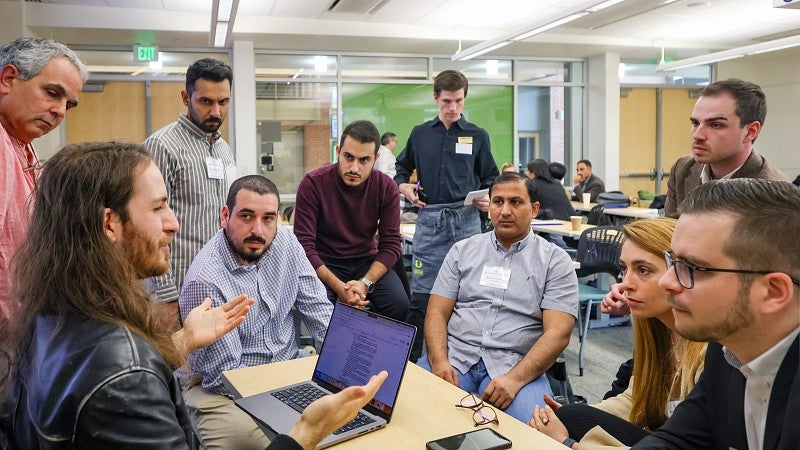
Walth said the Catalyst program was born out of the desire for undergraduate students to see their work published.
“It struck me that for too long, the journalism school has treated classroom assignments like term papers and not potential journalism,” Walth said.
Walth’s co-director for both programs, Nicole Dahmen, sees them as the “bridge between the classroom and the life of a working journalist.”
Alumni of the program agree.
“My Snowden experience was unparalleled. The SOJC does a great job at preparing its students, but the experience you get from actually being in the field reporting is so valuable,” said Booker, a former Snowden intern. “The experience of writing for a news publication is so valuable. There are some things you just won’t learn until you’re in the thick of it.”
Booker’s Snowden internship was at The Columbian, where she reported on local news for 10 weeks the summer after she graduated. Once her internship was over, the paper hired her as a full-time journalist. Weisend was a Snowden intern at The Astorian, a community newspaper on the coast of Oregon, and a member of the Catalyst program. She decided to apply to both programs after realizing that many of her favorite journalists had followed the same track.
Bentley Freeman ’24 worked at the Baker City Herald, the local newspaper of a small town in Oregon. During his internship, he had to develop strong relationships with the community to be able to tell its stories well.
“You have to build a rapport in the community,” Freeman said. “I had to almost earn and build that respect by going out to community events, going out and talking to people, being like, ‘Hey, I’m Bentley Freeman, the Snowden intern for the Herald this summer. Very nice to meet you. What can you tell me about so and so?’”
Freeman also worked as an intern for Eugene Weekly, where he said he was thrown into the professional environment as a real reporter. While interviewing inmates in correctional facilities, interviewing Governor Tina Kotek and attending ride-alongs with the sheriff, he realized he loved journalism because of the deeper understanding he gained from the topics he was covering.
“The key is, if you’re going to write about something, you can’t just write about it because you think the readers will be interested. No, you have to be interested,” Freeman said. “Find your creative North Star. Find something key that can guide you so you always have a firm visual of the story.”
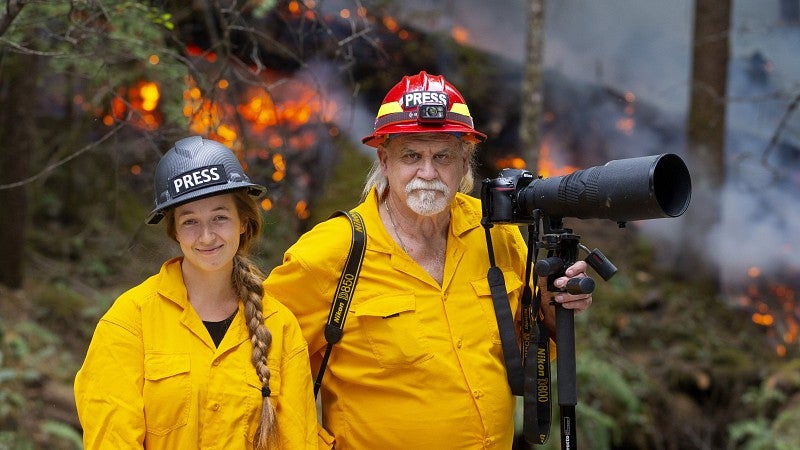

A strong journalism program invests in multimedia
In addition to core classes such as writing and media ethics, journalism majors take classes ranging from documentary production to newspaper editing and reporting. For alum Ryan Nguyen ’21, the skills he learned in the journalism program helped him land his position as news producer for The Seattle Times. His role includes social media, moderating comments and curating the paper’s homepage.
“Thinking about news values, thinking about ethics, thinking about newsworthiness, timeliness, and it has made me feel very confident that I’m able to do my job and do it well,” R. Nguyen said. “Curating the homepage is such a big deal for how readers get to us and what they see. It’s kind of like the front page of a newspaper. Making sure that it has stories that are relevant to our audience and encapsulates all the diverse interests of our audience is really important, so that’s something we spend a lot of time on.”
Madison Yeash ’24 said SOJC courses help students build hard skills, like using software programs, managing files and producing news in creative ways. She’s also had support and encouragement from her professors, such when Dan Morrison helped her publish video stories on the KVAL and KMTR websites, and Charlie Deitz motivated her to create her own opportunities, such as co-founding Amplify, the SOJC Audio Club.
Yeash says inspiration for starting Amplify came after seeing how powerful a tool podcasting and audio can be for journalistic storytelling.
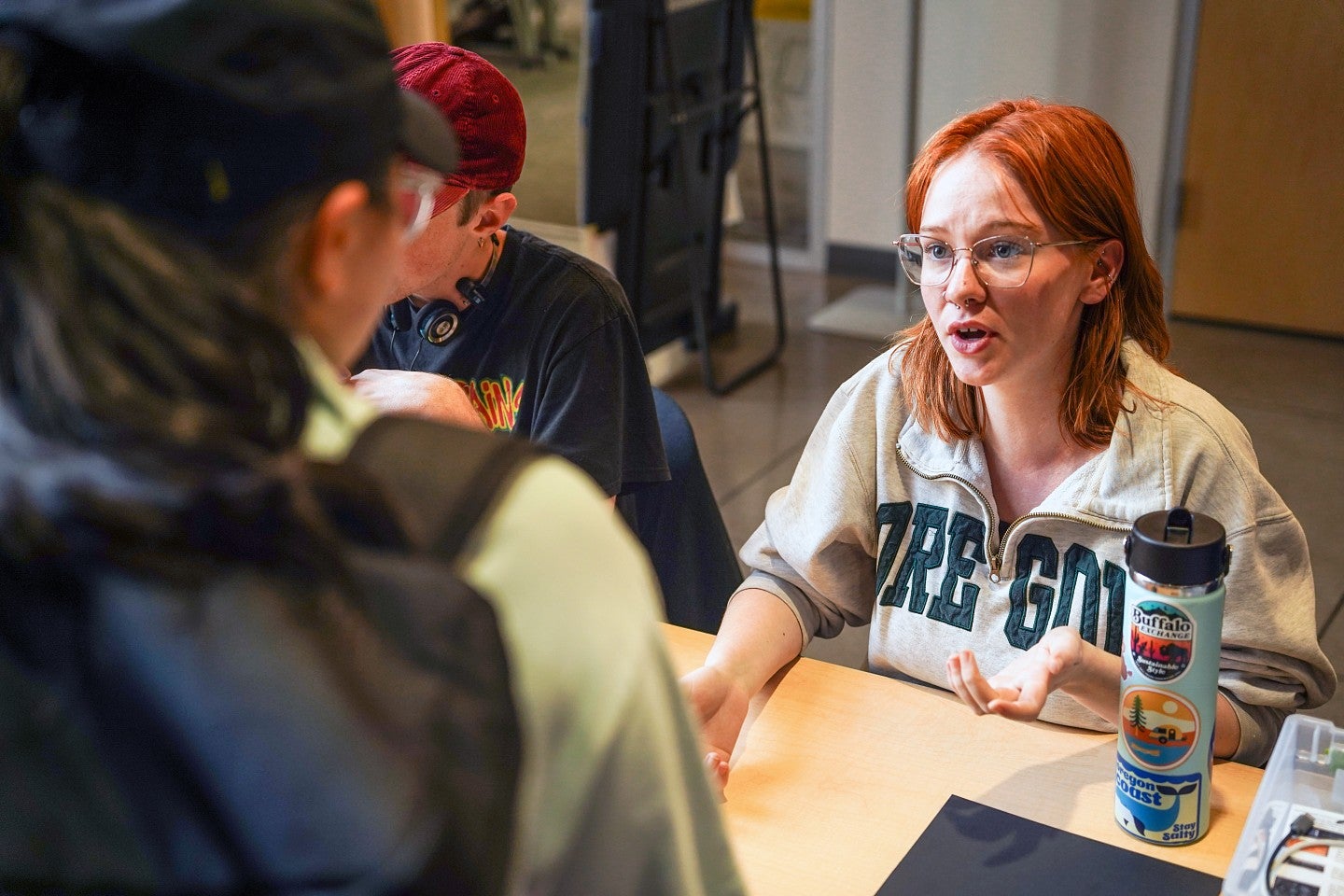
“Audio is an incredibly powerful storytelling tool in journalism. Listening to someone’s voice tell you their story can be personal and connect people to the story in a way that other mediums can’t,” she said. “[Amplify] has been a cool experience because I have gotten to hear everyone’s podcast pitches and ideas. I am personally working on a podcast where I take real vintage voicemail recordings and turn them into a fictional, narrative-driven audio experience. Audio storytelling can be almost anything you can think of, which makes it super special.”
Advertising and journalism major Ainsley Maddalena’s first assignment at FLUX magazine, an SOJC student-run magazine, was focused on a farm that helped people recover from substance abuse. She traveled five times to the farm, which is around two hours away from Eugene, with photographer Kyle Prince to speak with farmers. Their final piece was “Hands-On Healing.”
“Working on a story about [substance abuse] and being able to talk to people who’ve been through that and bring a platform to it, that was just so incredible, and I feel so honored to have been assigned that,” Maddalena said.
For Maddalena, the hands-on-experiences she has gained in the SOJC’s student organizations complements the values of storytelling and ethics she is learning about in her classes. Maddalena took a class with Radcliffe that focused on social media journalism, with a constantly changing curriculum.
“The big shifts that we've seen in terms of the way we teach journalism is recognizing the rise of new platforms and ensuring that our students are equipped to be able to tell stories for those platforms,” Radcliffe said.
He said the changes in technology have led to an explosion in news and information, but it isn’t always accurate. Learning to identify misinformation and verify sources, often coming from regular citizens and not journalists, is another skill students have to learn.
This idea of making sense of what’s true in the digital age is a key concept behind a core course for journalism students, Fact or Fiction. Lewis, who teaches the class, said the course is focused on giving students a solid grounding in the tools and concepts of information verification.

“Importantly, too, we’re not just talking about news and media literacy; the class also introduces students to key issues in data literacy — that is, how to avoid being deceived by charts and graphs — and numeracy — that is, how to avoid mistakes with numbers and stats,” Lewis said. “Overall, our goal is to equip students with a foundation in these kinds of literacies so they can avoid being duped and help others do the same.”
The SOJC also offers the Multimedia Journalism Master’s program (MMJ), which teaches journalism students advanced skills in videography, photography, drone and 360-degree video production, audio storytelling and more to allow them to tell bigger stories for a more diverse audience interested in getting their news from both traditional and nontraditional platforms.
“I did not anticipate the many career opportunities that would open for me when I enrolled in the master’s program,” said Jane Glazer, a master’s student in the MMJ program at SOJC Portland. “Specifically, the MMJ program exposed me to media production — a broader way to use storytelling skills. I gained access to fancy cameras, audio equipment and lighting technology, and I was challenged to be more creative than I was used to in my previous reporting experiences.”
Glazer and her fellow cohort members in the MMJ program made a documentary about racism in Portland, Oregon, dating back to the Lewis and Clark Expedition. It tells a story that has been left out of history books and is an example of the power of telling stories through a variety of media.
Master’s and advanced journalism
Professor Ed Madison developed the SOJC Media Innovation Lab for students on campus to experiment with and learn about the business of media and new ways of storytelling. Madison has guided students through developing real-world apps, having conversations with investors and crafting companies based on ideas fostered in the lab. This opportunity keeps students’ fingers on the pulse of technology while holding the foundations of journalism at the forefront of their minds.
Madison also applauds how the SOJC is leading the charge on teaching budding journalists about artificial intelligence (AI) and augmented reality (AR).
“I don't know what other schools are delving into AI as rapidly as we are. Also, in terms of AR and immersive worlds, we've got a whole master’s degree program, and I think we're one of the first schools to launch that,” said Madison. “We’re always forward thinking. I think that's what's exciting about Oregon.”
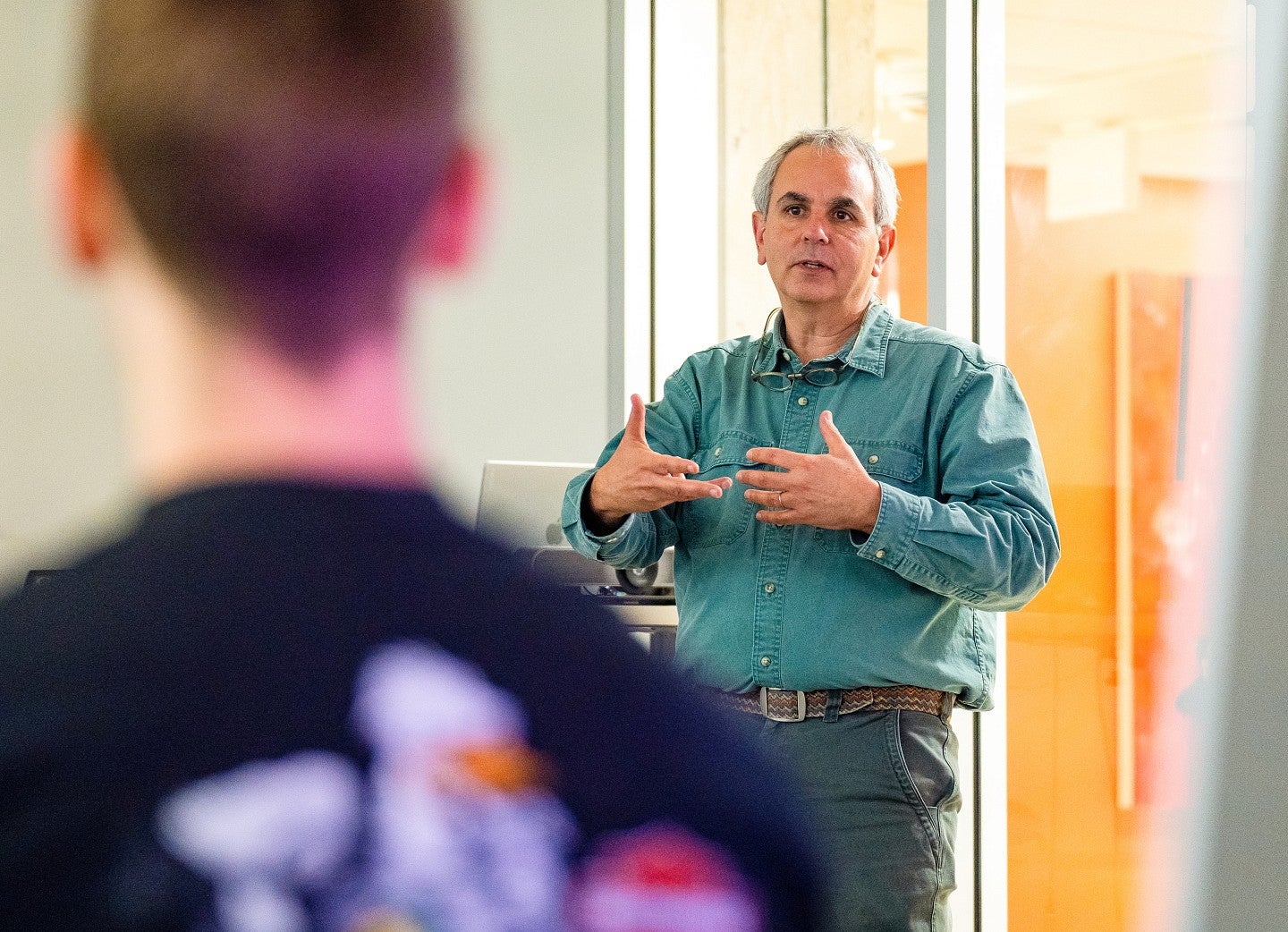
When students want to further their journalism knowledge and experience, many turn to the Journalism Master’s program at the SOJC. Will Yurman is the interim director of the program as well as an instructor of undergraduate classes in journalism. He believes the master’s program gives students a chance to dive deeper into journalism than in the undergraduate program and fully immerse themselves in their curiosity about the world.
“It's really a chance to explore. In some ways it's just basics — being a good journalist is being curious about the world. It's strong writing skills. It's learning how to ask hard questions. It's being a critical thinker,” said Yurman. “A lot of the skills we teach would apply to almost any job you could possibly imagine, and I think we also try to stay on the cutting edge of what's new in the field, both in terms of technology and also the business side of things.”
"I applied for the School of Journalism and Communication because I wanted to pursue my lifelong passion for writing,” said journalism master’s alum Sierra McClain ’19, who is now working as a fellow for The Wall Street Journal. “I definitely felt equipped by a lot of the classes that I took to step out into the journalism world.”
As journalism evolves, DeVigal said he tries to keep a Wayne Gretzky quote in mind: “Don’t go where the puck is, go where the puck is going.” For him, this means looking at how people are consuming information and sharing information.
Students interested in working in journalism can count on the SOJC to provide the strongest foundation in journalism as well as an advanced perspective on the changing landscape of the field and the skills needed to adapt.
—By Ella Norton, class of ’24 and Jillian Gray, class of '25
Ella Norton (she/her/hers) is a senior majoring in public relations and French from Kansas City, Missouri. She is a copy editor for Align Magazine, an account executive for Allen Hall Public Relations and a student ambassador for the School of Journalism and Communication.
Jillian Gray, class of ’25, is a public relations major with a minor in digital humanities. Outside of Allen Hall Jillian enjoys watching “Gilmore Girls” and taking trips to Barnes and Noble. Connect with Gray on LinkedIn.
